How to Grow Beans From Seed to Harvest
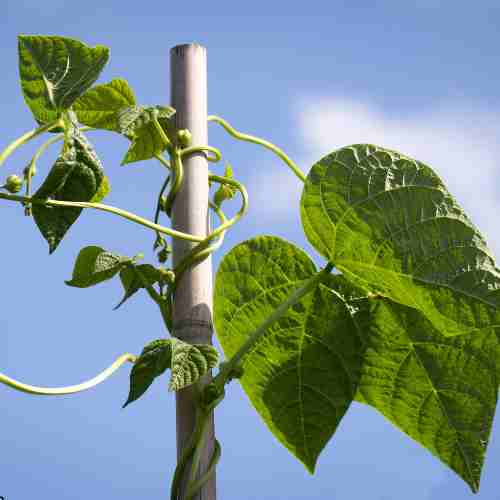
Beans are one of the easiest and most rewarding vegetables to grow. Whether you choose bush beans for their compact growth or pole beans for their climbing vines, these high-yield crops provide fresh, delicious pods all season long. Plus, they fix nitrogen in the soil, improving garden fertility for future crops.
In this guide, we’ll cover everything you need to know—from planting and care to harvesting and storage—so you can enjoy a continuous supply of homegrown beans!
Get our Gardening Buddy and find veggies that fit your conditions best.
You Can Grow It!
Why Grow Beans?
Beans are versatile, nutritious, and beginner-friendly. They thrive in various climates, require minimal maintenance, and produce abundant harvests in small spaces.
Benefits of Growing Beans
✅ High-Yield Crop: A small planting provides weeks of fresh beans.
✅ Fast-Growing: Some varieties mature in just 50–60 days.
✅ Improves Soil Health: Beans add nitrogen to the soil, benefiting other plants.
✅ Space-Efficient: Pole beans grow vertically, making them ideal for small gardens.
✅ Nutrient-Rich: Packed with fiber, protein, and vitamins A & C.
Excited to grow your own? Let’s get started!
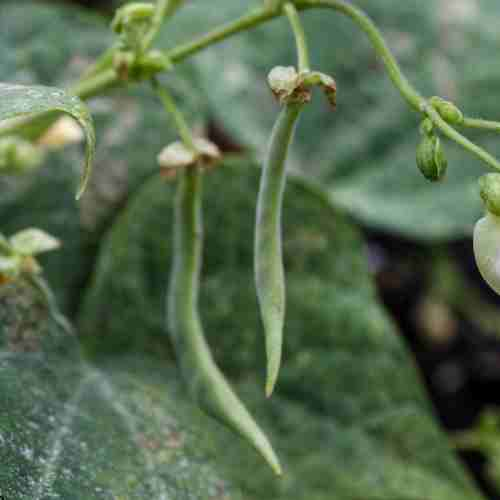
Choosing the Right Bean Variety
There are two main types of beans, each suited for different garden setups.
1. Bush Beans (Compact and Quick-Maturing)
- Growth: Stays small and bushy, no trellis needed.
- Harvest Time: Ready in 50–60 days.
- Varieties:
- ‘Blue Lake 274’ – Classic green bean, high-yielding.
- ‘Provider’ – Early maturing, great for cooler climates.
- ‘Contender’ – Heat-tolerant, resistant to diseases.
2. Pole Beans (Vining and High-Yielding)
- Growth: Climbs 6–10 feet, requires a trellis or support.
- Harvest Time: Takes longer (60–80 days) but produces continuously.
- Varieties:
- ‘Kentucky Wonder’ – Heavy producer with tender pods.
- ‘Scarlet Runner’ – Beautiful red flowers, edible pods and beans.
- ‘Fortex’ – Extra-long, stringless beans.
🌱 Tip: If you want a quick harvest, choose bush beans. For longer production, go with pole beans.
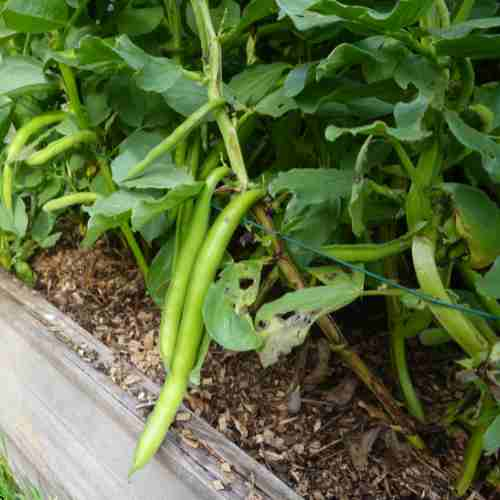
When to Plant Beans
Beans love warm soil and should be planted after the risk of frost has passed.
Spring & Summer Planting (Best for most climates)
- Plant beans 2–3 weeks after the last frost when the soil is at least 60°F (16°C).
- If planting in successions, sow new seeds every 2–3 weeks for a continuous harvest.
Fall Planting (For warm climates, Zones 8–10)
- In hotter regions, plant beans in late summer or early fall to avoid extreme heat.
🌱 Pro Tip: Beans don’t transplant well—direct sow seeds in the garden for best results.
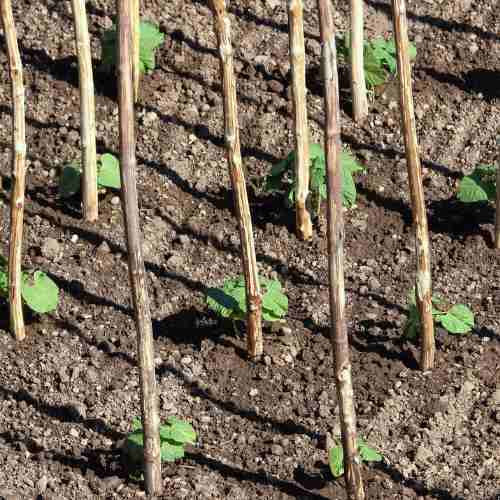
How to Plant Beans
1. Choose the Right Location
- Full sun (at least 6–8 hours of direct light daily).
- Well-draining soil with a pH of 6.0–7.0.
- Avoid planting in areas with high nitrogen—too much nitrogen encourages leaf growth instead of beans.
2. Prepare the Soil
- Loosen the soil and mix in compost or aged manure for nutrients.
- Avoid adding extra fertilizer—beans fix their own nitrogen.
3. Planting the Seeds
- Bush Beans: Space seeds 2–3 inches apart, in rows 18 inches apart.
- Pole Beans: Space seeds 4–6 inches apart, providing a trellis, stake, or netting for climbing.
- Depth: Plant seeds 1 inch deep in moist soil.
🚿 Water well after planting, but don’t overwater—beans prefer slightly dry conditions.
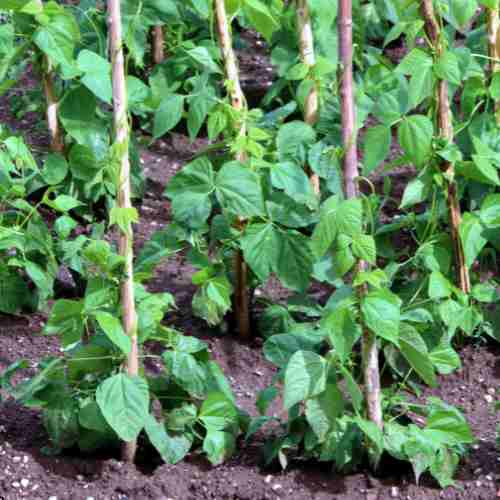
Caring for Bean Plants
1. Supporting Pole Beans
- Install a trellis, teepee, or fence before planting to avoid damaging roots later.
- Sturdy poles should be at least 6 feet tall to support vigorous vines.
2. Watering
- Beans need about 1 inch of water per week.
- Avoid overwatering, as soggy soil can cause root rot.
- Water at the base of plants to prevent fungal diseases.
🌱 Tip: Mulch around plants to retain moisture and suppress weeds.
3. Fertilizing
- Beans rarely need fertilizer! If the plants look pale, apply a low-nitrogen fertilizer.
- Too much fertilizer causes lush leaves but fewer beans.
4. Pest & Disease Control
🐛 Common Pests:
- Aphids – Spray with water or use neem oil.
- Mexican Bean Beetles – Handpick beetles or introduce ladybugs.
- Cutworms & Slugs – Use diatomaceous earth around plants.
🚫 Preventing Diseases:
- Rotate crops yearly to prevent soil-borne diseases like rust and blight.
- Avoid overhead watering to prevent powdery mildew.
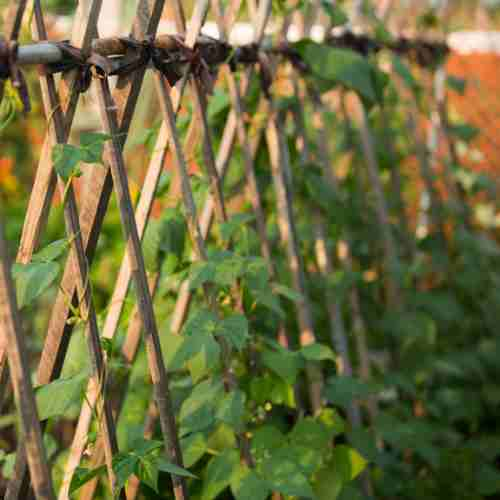
When and How to Harvest Beans
Beans are ready to harvest in 50–80 days, depending on the variety.
1. Harvesting Bush Beans
- Pick when pods are firm and crisp (about 4–6 inches long).
- Harvest every 2–3 days to keep plants producing.
2. Harvesting Pole Beans
- Start picking when pods are tender but before seeds fully develop.
- Continuous harvesting = more beans!
🌱 Pro Tip: Don’t yank pods off the plant—use two hands to avoid damaging vines.
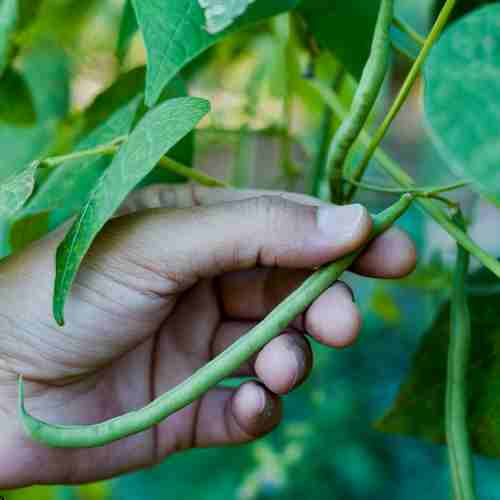
Storing and Using Beans
🥬 Storage Tips:
- Store fresh beans in a plastic bag in the fridge for up to a week.
- For long-term storage, blanch and freeze beans.
🍽️ How to Use Them:
- Steam or sauté with garlic and butter.
- Add to soups, stir-fries, or salads.
- Can or pickle for year-round enjoyment.
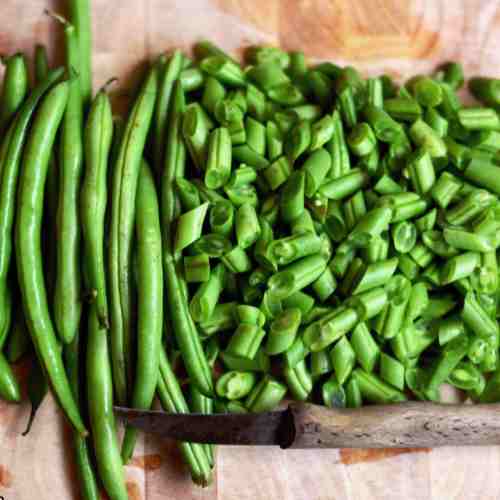
FAQs About Growing Beans
How long do beans take to grow?
Most varieties take 50–80 days to mature.
Can beans grow in containers?
Yes! Use a deep container (at least 12 inches) and provide a trellis for pole beans.
Do beans need full sun?
Yes, they need at least 6–8 hours of sunlight daily.
How often should I water beans?
Water once a week, keeping soil moist but not soggy.
Can I grow beans indoors?
Bush beans can grow indoors with enough light, but pole beans need more space.
Why are my bean plants not producing?
Likely due to too much nitrogen, lack of pollination, or excessive heat.
Do beans need fertilizer?
No, they fix their own nitrogen. Too much fertilizer reduces yields.
What’s the best trellis for pole beans?
A teepee, fence, or netting at least 6 feet tall.
How do I store fresh beans?
Refrigerate for up to a week or freeze after blanching.
Why are my beans tough?
Overripe beans become tough—pick them young for the best texture!
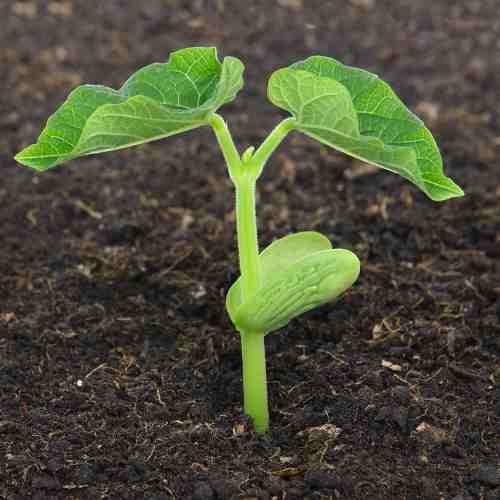
Final Tips for a Successful Bean Harvest
✅ Direct sow seeds – Beans don’t transplant well.
✅ Provide support – Pole beans need trellises for best growth.
✅ Water consistently – But avoid soggy soil.
✅ Pick often – Frequent harvesting boosts production.
✅ Rotate crops – Prevents soil depletion and diseases.
Growing beans is simple, fun, and rewarding. Whether you’re growing a small batch in containers or a large row in your garden, these high-yield plants will keep your meals stocked with fresh, delicious beans all season long!
Get our Gardening Buddy and find veggies that fit your conditions best.
You Can Grow It!
Partners and Sponsors
We are forever grateful to our partners and sponsors. Send an email to team @ strongecho.com and let’s see how we can grow each other’s impact!





